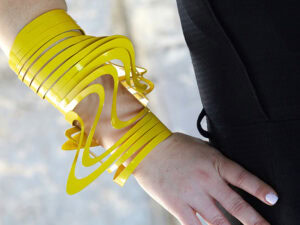
This article is about the most risky and radical material I know: the Idea. But I’d like to begin with a small prelude of a fateful meeting that made me think about this topic. A few years ago, I happened to be sitting at the same table as an 85-year-old gentleman in a small mountain village in Central Italy. The first thing he taught me at 9 a.m. in the morning was how to drink coffee in the proper local way. We both ordered a strong small espresso and diluted it with some anise vodka.
We were sitting beside the door of the local chapel and he started to talk about the argument he had with the local clergyman. The Book of John in the New Testament starts with a phrase: “In the Beginning was the Word.” In the original Koine Greek, it reads: “Ἐν ἀρχῇ ἦν ὁ λόγος.” The old man wasn’t satisfied with that translation. The word “logos” has many different meanings, and because different languages grammatically and symbolically don’t match perfectly with each other, he was worried that the true meaning has been lost. Throughout time, “logos” has been translated as thought, speech, proportion, principle, logic, idea, meaning, and reason. In that case, we could argue, based on the Bible, that the basic material of every existing object is the Idea. The Meaning. The Reason. I especially love the word reason. The further we go from the modernistic linear, boundaries-pushing, “what I do today will be history tomorrow” way of thinking, it becomes more and more important to ask “why” instead of “what.”
I have heard from several ceramic artists that they have found themselves thinking about this question: What’s more important, the vessel or the space inside the vessel? In a similar way, we keep asking as jewelry artists what weighs more: the piece of jewelry itself or the reason why it was made? The idea. Cause-consequence relationship. Causality. Bridges, ties, connections. I have been interested in history for a long time and have visited archaeological excavations in Estonia since my late teenage years. These objects make people talk a lot about the nature of the makers and past times. While investigating local Estonian archaeological material, I noticed a kind of regularity draw out. In restless and stormy times, the jewelry of military noblemen and people in the higher social classes became larger and more decorated to emphasize and secure their economic position through visual symbols. In peaceful times, a more modest and laconic style appears. From that, a question arises: Which is more important, conspicuous jewelry or the need to secure the position, which forced the jewelry to go big? By investigating material culture, we are able to open a door into the psychology of historic people. To enter the world of their fears and lusts.
Please take a look and guess what could be in the following picture.
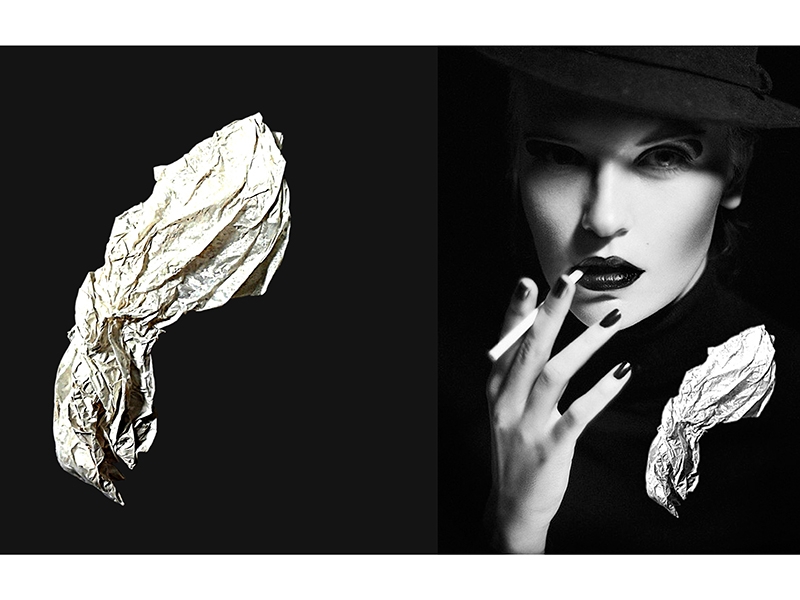
Because this article appears on a website that talks about contemporary art jewelry and the main audience belongs to the network of contemporary art jewelry makers, theorists, and collectors, then undoubtedly the immediate answer will be that this is a piece of contemporary art jewelry. A brooch, to be more accurate, because it seems to stay on the model without a chain or other visible construction. As you have by now probably started to suspect, I’ve actually tried to trick you. I photographed a piece of dirty plastic that was protecting the floor while painting the walls of a studio that was under repair, then pasted it onto an image of a model. Sounds rough, but our ideas about jewelry are what turns this piece of flotsam into a piece of contemporary art jewelry.
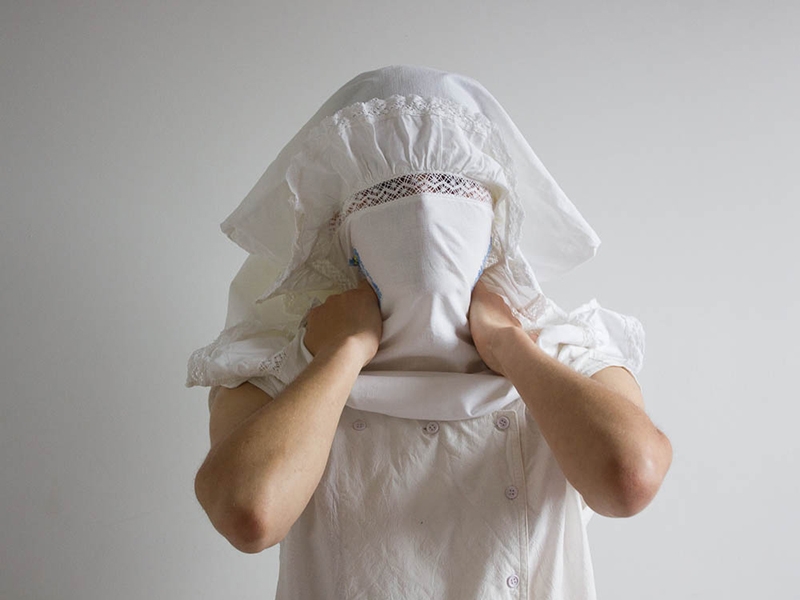
In a way, we’re ruined by ideas. We see everything through a filter of meanings. We almost never hear any pure abstract sounds. We hear the scream of a person who stepped on the crosswalk. The loud creak made by the brakes of the car that stopped just an inch from the pedestrian. The agressive signal from the car coming from behind that had to make a sudden stop. The working engines of the gathered cars and the nasty rattling noise of the passing scooter. But never pure abstract sounds. The world is noise. Traffic noise. Emotional noise. Visual noise. The human brain has learned how to select and classify noise. If we couldn’t separate and interpret in the traffic the threatening sound of a specific car that is too close, then we would just get killed. Analyzing the reasons, finding connections, and conceptualizing are primary functions of survival. Questions of life and death. Conceptualizing jewelry art (like any other art form) is not only a cultural construction, but a genetically built-in biosemiotic reflex. In that way, we are not able to create a single object that does not use a sign and the meaning behind the sign as a primary material, because in the end it’s just a question of communication.
There are a lot of unusual materials that artists use to expand the borders of jewelry: blood, tears, ashes, animal guts, flesh… But these borders still exist in physical dimensions. Now, what happens when jewelry loses its tangibility? When the idea itself becomes the most radical and precarious material that destroys even the materiality of jewelry? When there is no other material to rely on than your own imagination?
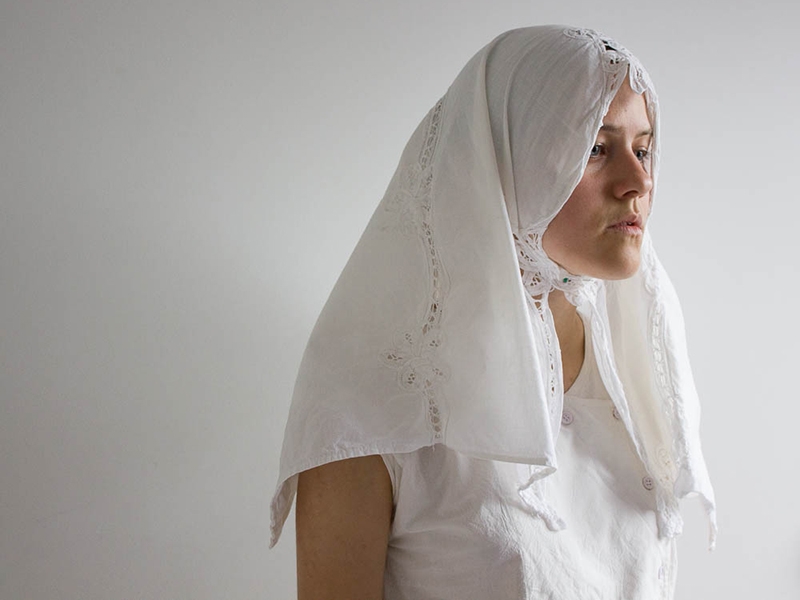
In the year 1973, Gijs Bakker imposed some marks on a naked human body with a piece of gold wire, photographed it, and called it Shadow Jewelry (Schaduwdieraad). This piece was displayed at Stedelijk Museum in Amsterdam. But what did the museum have? And did they have the original piece? What is the original piece? Is it the image on the photographic film that captures the idea? Is it the negative or the first print? Is it the reproduction of the image that can be printed out in any size and quantity? The photograph is also always accompanied by a bracelet of gold wire inside a signed velvet box, but it isn’t the same piece of metal that was used to leave the marks. I could say that the museum acquired the idea. The concept. The significant symbol, because this piece of jewelry is meant to be worn in the mind and soul. And it’s not the artistic quality of these photos that impresses us, it’s the story behind the image. If I were to stab someone with a knife, then it is nothing else than increasing the amount of iron in someone’s body. But it’s the idea surrounding stabbing that turns it into a crime.
Many art pieces are meant to vanish. They exist just for a moment, like a sharp flash of light, but if you close your eyes the afterglow will stay imprinted on the cornea. For her piece I wished to marry. It did not work out, Estonian jewelry artist Anna-Maria Saar wrapped her head in old Dutch pillowcases, imitating the traditional headdresses of married women from various cultures and religions. These pieces lasted just for a few seconds, as intimate moments between the artist and photographer. After the fatal shots of the camera, these pieces got whipped off from the head with a single hand gesture; but thanks to the existence of the photographs, they can create new personal connections in our fantasies again and again.
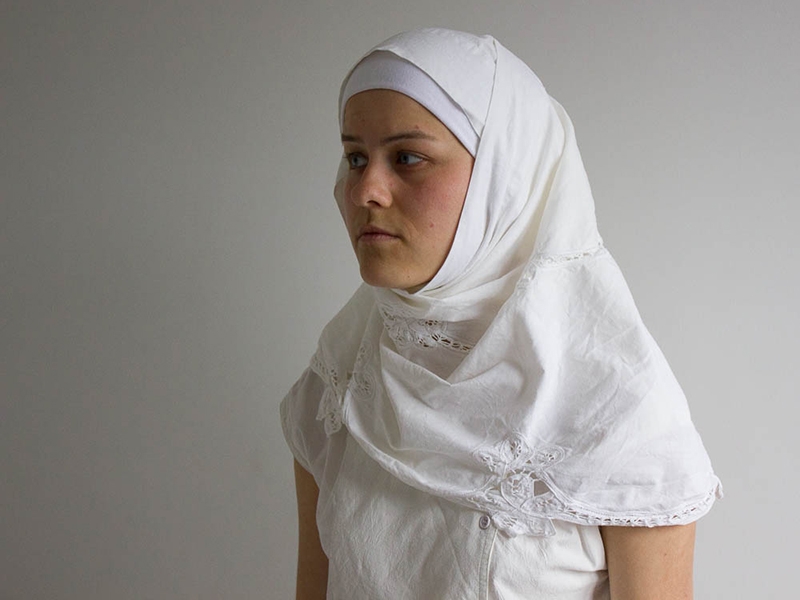
Artists wishing to create transient pieces while working with personal issues is understandable. Why should someone raise a permanent monument to mark his inner struggles? Why should he turn his problems into wearable objects, especially when most pieces of jewelry are almost never worn? Showcases are not the only prison cells where jewelry pieces await the arrival of the savior, as Sleeping Beauty does. Most of the time, jewelry belongs to drawers, shelves, boxes, sinks, floor cracks, sofa gaps, safes, beach sand, handbags, pawn shops, etc. I received a present, a brooch, made by my coursemate, who committed suicide. Sometimes I take it out from its special box, wipe the surface with my sleeve, look at it, and seal it again into the box. I wear it every day even though I have never attached it to my body. Most pieces of jewelry are not meant to be worn physically, but spiritually. From that perspective, the retreat of physical materiality sounds totally logical and acceptable, perhaps even desirable.

In the age of information overload, there’s a very small amount of pieces that we have seen and also experienced in the physical world. Instead of handling jewelry, we are are accustomed to touching our touchscreens. Today most goldsmithing companies use 3D renderings on their websites instead of real photographs of real works. And thanks to the digital world, physical reality becomes just one of the layers among many layers where we can exist. In the cult science fiction movie The Matrix Reloaded, there is a villain who offers a cake and says that it is a very special cake—he programmed it himself. At the time of the movie’s release, it sounded strange, but not in the current Internet marketing context, where we buy nothing other than really genuine computer codes. Which raises the question, is it real? Are our ideas a real material, or are they just illusions?

Let’s go back to God. Estonian scientist Tiit Lukki was asked if God exists. And he replied: “Of course.” He could even calculate the attraction force of God. For example, we could calculate the approximate amount of energy that all the humans who go to church on Sunday mornings use. Of course that kind of calculation would take impossible time and effort, but we can be sure that this energy used by billions of religious people every week is real energy, energy that could literally move mountains! Even though I’m not religious, it is impossible for me to say that God does not exist. In that light, we could say that even if those pieces described above have no physical presence, they still have influence on how we make and think about jewelry in the present day, and we cannot call them just illusions.
* * *
Idee kui materjal
Translated from the Estonian by Urmas Lüüs
See artikkel jutustab ühest kõige radikaalsemast ja riskantsemast materjalist, mida ma tean – ideest. Kuid lubage alustada põgusa eellooga, mis pani mind antud teema üle sügavamalt mõtisklema. Paar aastat tagasi juhtusin ühes väikese Kesk-Itaalia mägiküla kohvikus samasse lauda 85 aastase härrasmehega. Esimese asjana õpetas ta mulle kell üheksa hommikul, kuidas kohaliku traditsiooni kohaselt kohvi juua. Tellisime mõlemad kange espresso ja kallasime sinna sisse „lahjenduseks“ pitsi aniisiviina. Istusime täpselt kohaliku kabeli ukse all ning jutt veeres tema paari päeva eest toimunud vaidlusele kabelis hingekarjasena teeniva vaimulikuga. Uue Testamendi Johannese esimene kiri algab fraasiga „Alguses oli sõna…“ Algupärases vanakreeka keele Aleksandria murdes: “ Ἐν ἀρχῇ ἦν ὁ λόγος,…“ Vanahärra selle tõlkega rahul ei olnud. Terminil „logos“ on palju erinevaid tähendusi ning kuna eri keeled üksteisega grammatiliselt ja sümboliliselt identselt ei kattu, siis tema arvates on selle sõna sisu läbi tõlgete kaotsi läinud. Aja jooksul on logos´t tõlgitud kui mõte, kõne, proportsioon, printsiip, loogika, idee, tähendus ja põhjus. Seetõttu saame Piiblile tuginedes väita, et kõige olemasoleva baasmaterjaliks on idee. Tähendus. Põhjus. Neist enim on mulle hingelähedane „põhjus“. Mida kaugemale me triivime modernistlikust lineaarsest piire kompavast „mis täna tehtud, see homme ajalugu“ lähenemisest, seda olulisemaks muutub küsisõna „mis“ asemel „miks“.
Olen sattunud kuulma mitmelt keraamikult, et nad on tabanud end taas ja taas mõtlemas küsimusele, mis on olulisem kas anum või ruum anuma sees. Niisamuti tuletavad ehtekunstnikele end meelde sisemised kaalukausid – ühe peal ehe ja teisel põhjus, miks ehe sai loodud. Idee. Põhjus-tagajärg seos. Kausaalsus. Sillad, sidemed, ühendused. Uurides kohalikku Eesti arheoloogilist materjali joonistub välja tajutav seaduspära. Rahututel ja tormistel aegadel muutuvad sõjalise ülikkonna ja ühiskondlikult positsioonilt kõrgemal astmel seisvate isikute ehted suuremaks ja rikkalikumaks. Kindlustatakse läbi visuaalsete tingmärkide ühiskondlikku positsiooni. Rahuajal seevastu suurustamine taandub ning valdavaks saab tagasihoidlikum ja lakoonilisem stiil. Sellest johtuvalt võib esitada sarnase küsimuse. Kumb on olulisem, kas silmatorkav ehe või vajadus staatust markeerida, mis ehte suureks paisutas? Luues materiaalse kultuuri abil ajaloolist tervikut, avab see ukse tollase inimese hingeellu. Tema hirmude ja himude tallermaale.
Palun vaadake allolevat pilti ning mõtelge, mis objektiga on tegu.

Kuna artikkel ilmub kaasaegset ehtekunsti esindava organisatsiooni kodulehel ja selle põhiline lugejaskond kuulub kaasaegse ehtekunsti valmistajate, mõtestajate või kollektsioneerijate ringkonda, siis suure tõenäosusega ei teki kellelgi kahtlust, et tegu on kaasaegse ehtekunstiga. Täpsustatult prossiga, sest objekt näib püsivat modellil ilma keti või muu nähtava konstruktsioonita. Nagu arvatavasti juba aimate, siis üritan teid tüssata. Tegelikult pildistasin remonditööde ajal värviseks saanud ning pärast kasutamist kägarasse nartsutatud ja põrandale ülejäänud prügi sisse vedelema jäänud kiletükki. Kõlab käredalt, aga just idee on see, mis muudab selle nö tüki sitta kaasaegseks ehtekunsti taieseks.
Kohati on meie mõtlemine teadmiste poolt rikutud. Adume kõike endi ümber asuvat läbi märkide ja ideede filtri. Me ei kuule pea eal puhtaid abstraktseid helisid. Me kuuleme ülekäigurajal teele astunud inimese kiljatust. Temast vaid tolli jagu varem pidama saanud auto pidurikriginat. Selle auto taga äkkpidurduse sooritanud juhi vihast signaalitörtsakat. Rodus seisma jäänud masinate mootorite tuksumist ja kolonnist mööda manööverdava rolleri jäledat plärinat. Aga mitte puhtaid abstraktseid helisid. Maailm on müra. Liiklusmüra. Suhtemüra. Visuaalne müra. Inimese aju on õppinud müra selekteerima ja liigitama. Kui me ei oleks liiklusmürast võimelised eraldama ja hindama ohuna ühe kindla liiga lähedal sõitva auto häält, saaksime me lihtsalt surma. Põhjuste analüüs, seoste leidmine ja mõtestamine on elementaarne alalhoiuinstinkt. Elu ja surma küsimus. Ehtekunsti (nii nagu ka muude kunstiliikide) mõtestamine ei ole vaid kultuuriline konstruktsioon ja peenutsemine vaid geneetiliselt sisseehitatud biosemiootiline refleks. Samamoodi pole inimene võimeline valmistama ühtegi objekti, mille algmaterjaliks poleks märk ja märgi taga olev tähendus, sest lõpuks taandub kõik ikkagi kommunikatsioonile.
Kunstnikud on üritanud laiendada ehete olemuse piire, võttes kasutusele lõputu koguse erinevaid materjale. Veri, pisarad, tuhk, loomasoolikad, toores liha… Kuid need piirid eksisteerivad endiselt füüsilises mõõtkavas. Mis juhtub, kui ehe kaotab kombatavuse? Kui idee ise muutub sedavõrd riskantseks ja radikaalseks, et hävitab ehte materiaalsuse? Kui pole haarata ühestki muust pidepunktist peale omaenese kujutlusvõime? Aastal 1973 jättis Gijs Bakker kuldtraadiga paljale inimkehale jäljendid, jäädvustas fotokaameraga ning nimetas need „Varjueheteks“ (Schaduwsieraad). See teos oli pikalt eksponeeritud Amsterdamis Stedelijk´i Muuseumis. Aga mida muuseum omab? Kas nende valduses on originaalteos? Mis on siinpuhul originaal? On see filmiribale sööbinud kujutis? Negatiiv või esimene paberile ilmutatud foto? On see reproduktsioon, mida võib lõpututes suurustes ja kogustes välja printida? Foto kõrval on alati eksponeeritud ka sametkarbis kuldvõru. Samas pole tegu objektiga, millega jäeti toona kehale jäljed. Võiks öelda, et muuseum omandas endale idee. Kontseptsiooni. Märgilise sümboli, sest ennekõike on see ehe mõeldud hinges ja mõttes kandmiseks. Ja see pole otseselt nende fotode kunstiline kvaliteet mis meid „Varjuehete“ puhul lummab, vaid kujutise tagant paljastuv lugu. Kui ma pussitaks kedagi noaga, siis füüsikalises maailmas pole see miskit muud kui rauasisalduse järsk tõstmine inimorganismi kõhupiirkonnas. Vaid idee pussitamisest ja sotsiaalsetest tõekspidamistest muudab selle kuriteoks.
Paljud kunstiteosed on loodud hävima. Nad eksisteerivad vaid viivu nagu terav valgussähvatus, aga kui silmad sulgeda, jäävad järelmõjud märksa pikemaks silma sarvkestale hõõguma. Eesti ehtekunstnik Anna-Maria Saar mähkis oma teose „Ma soovisin abielluda. Sellest ei tulnud midagi välja“ jaoks pähe vanu Hollandi padjapüüre erinevate abielueas naiste traditsiooniliste peakatete eeskujul. Need teosed eksisteerisid loetud minutid. Intiimne hetk fotograafi ja kunstniku vahel. Vaid sekundiga said need pärast saatuslikku klõpsu ühe käeliigutusega peast pühitud, aga tänu jäädvustusele saavad taas ja taas meie fantaasias luua üha uusi isiklikke seoseid. Kunstniku taotlus luua isiklikke teemasid käsitledes kaduvaid teoseid on igati mõistetav. Milleks luua püsivat monumenti oma sisemisi heitluseid tähistama? Et keegi saaks selle ühiskasutatavas vetsus kraanikausi servale unustada? Enamikku ehetest ei kanta peaaegu kunagi. Vitriinkapid pole ainsad vangikambrid, kus ehted Okasroosikesena klaaskirstus päästja saabumist ootavad. Põhiliselt on ehete pärusmaaks sahtlid, riiulipealsed, karbikesed, valamuservad, põrandapraod, diivanivahed, seifid, rannaliiv, käekotid, pandimajad… Mulle kingiti pross, mille oli teinud varakult lahkunud ülikooli kursusekaaslane. Mõnikord võtan selle karbist välja, nühin pinna käiseotsaga üle, vaatan ja sulgen seejärel taas karpi. Kannan seda iga päev, vaatamata sellele, et pole kunagi rinda pannud. Enamik ehteid polegi mõeldud füüsiliseks kandmiseks vaid vaimseks. Sellest lähtuvalt tundub ka füüsilise vormi taandumine loogiline ja aktsepteeritav.

Digitaalse informatsiooni ülekülluse ajastul kogeme me füüsilises maailmas väga väikest hulka teostest, mida me oleme näinud. Ehete puudutamise asemel katsume puutetundlikke ekraane. Juba praegu kasutab enamik kullassepafirmasid oma kodulehtedel fotode asemel 3D renderdatud kujutisi. Tänu digitaalsele maailmale muutub füüsiline maailm vaid üheks kihistuseks paljude seas, kus me saame eksisteerida. Kultuslikus ulmefilmis „Matrix Reloaded“ pakub pahalane erilist kooki, öeldes, et programmeeris selle ise. Toona kõlas see jaburalt, kuid mitte tänapäevases veebiturunduslikus kontekstis, kus me valime oma oste eriti elutruude arvutikoodide seast. Tõstatub küsimus – on see päris? On meie ideed reaalne materjal või kõigest illusioon?

Kuid liigume lõpetuseks tagasi kõigekõrgema juurde. Eesti füüsikult Tiit Lukkilt küsiti kord, kas Jumal on olemas. Ja ta vastas, et muidugi. Ta võiks isegi välja arvutada Jumala külgetõmbejõu. Näiteks võiks ta liita kokku umbkaudse energiakoguse, mida inimesed kulutavad, et liikuda pühapäeva hommikuti kirikusse. Muidugi võtaks taoline arvutus võimatu koguse aega ja pühendumist, kuid võime olla kindlad, et tuletatav energiakogus võrduks mõne võimsa geoloogilise protsessiga. Ja me räägime reaalsest energiast. Energiast, mis sõna otseses mõttes võiks liigutada mägesid. Isegi olemata religioosne, on mul võimatu seeläbi eitada Jumala olemasolu. Selles valguses tõdeme, et isegi kui artiklis kirjeldatud kunstiteostel ei ole füüsilist keha, omavad nad ikkagi mõju sellele, kuidas me hetkel teeme ja mõtestame ehteid ning on võimatu tembeldada neid pelgalt illusiooniks.



